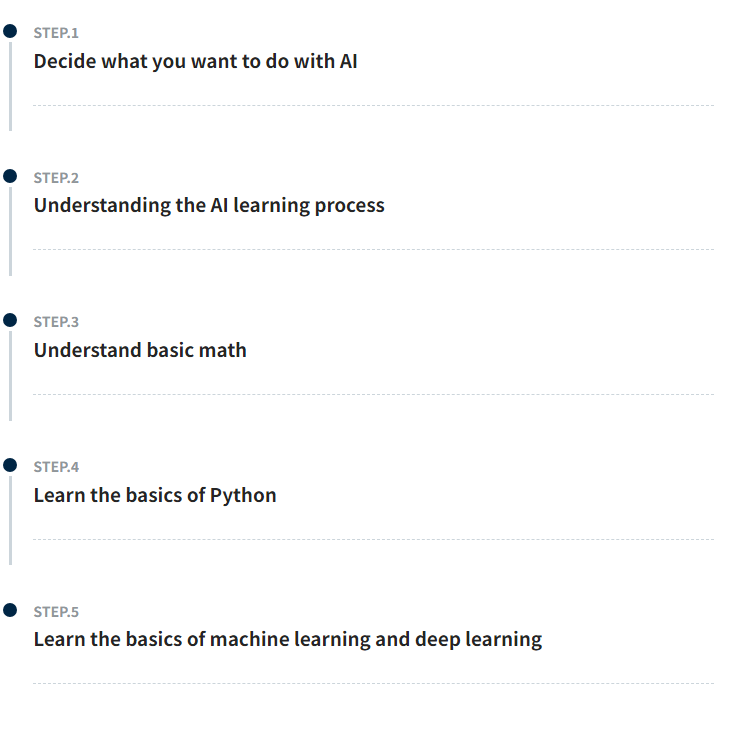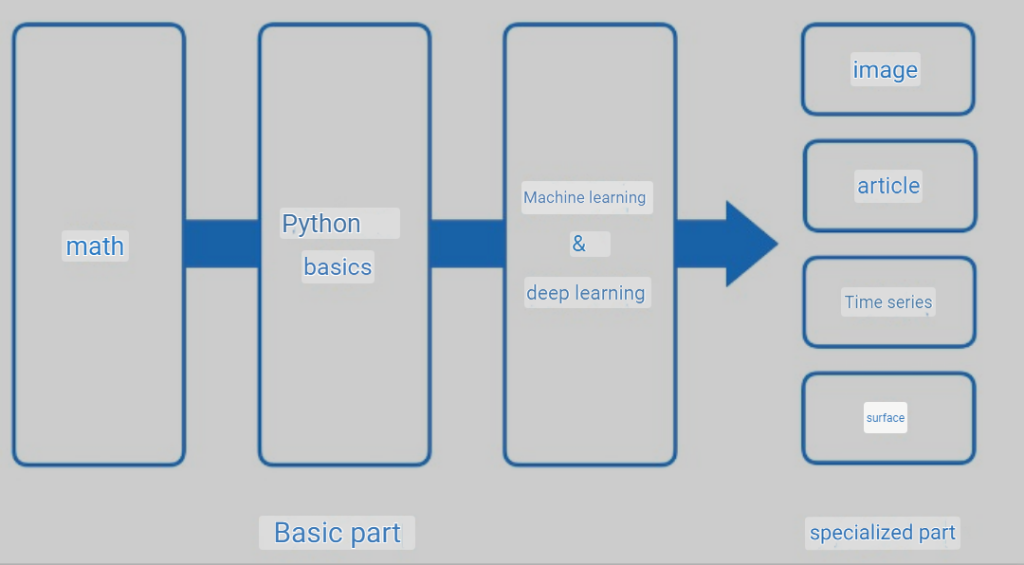This article is recommended for the following people:
- I want to learn AI but I don’t know where to start.
- I’m worried about whether I can learn AI even though I’m a liberal arts major and have no programming experience.
- I would like to know recommended websites and reference books for studying efficiently.
Recently, the topic of a shortage of AI talent has been appearing increasingly in the news, and many people are interested in AI and want to study it.
However, I think many people want to study but have questions about what they should study, how they should study it, and in what order.
In addition, many people with a liberal arts background who do not understand mathematics or who are complete beginners with no programming experience may be worried about whether they will be able to properly acquire knowledge and skills by studying in the first place.
5 steps to Teach Yourself AI

I will explain each one in order!
Step 1: Decide what you want to do with AI
summary
- It’s difficult to continue studying without a sense of purpose, such as “I want to do this with AI!”
- To do this, it is important to get an idea of what AI can do and how it can be used.
First, the first step is to clarify the purpose of starting to learn AI. This is very important. The speed at which you absorb knowledge and whether you can continue will be greatly affected by this sense of purpose.
If you are thinking about studying AI, here are some questions to ask yourself:
- Why do you want to learn AI?
- What do you want to do with AI?
In addition to this, if you also set a time frame for your goal, the whole picture will change.
Step 2: Understand the AI learning process
summary
- The key to success is to understand the general outline of what knowledge is required to acquire AI skills and understand the shortest route to your goal!
In Step 1, we asked participants to imagine the “person they want to become” after learning. Next, they need to understand the overall picture of the knowledge and skills required to get closer to that person they want to become .
If you think of it in terms of a journey, it might be easier to imagine Step 1 as holding a compass and Step 2 as holding a map .
The biggest problem for beginners is not knowing what to study, in what order, or how to study. First, clarify what you need to learn and then start studying.

The above diagram is merely one example.
What you will learn can be broadly divided into two parts.
Basic Part
This is the foundational foundation for acquiring AI skills and is something that everyone should learn.
- Mathematical knowledge required for machine learning
- Python programming skills
- Basic knowledge of machine learning and programming skills
Specialized Part
This part teaches skills tailored to each goal, based on the skills acquired in the basic part.
Four main types of data are used in machine learning. Of course, it is desirable to learn all of them, but you can study more efficiently by selecting what to learn based on your own goals.
- image data
- Text data
- Time series data (data with a context where the number of visitors on 1/1 is 100 people)
- Tabular data (such as that found in an Excel spreadsheet)
Now that you have a good understanding of the big picture, it’s time to move on to the big picture of how to study. Let’s introduce some specific study methods!
Step 3: Understand basic math
summary
- To understand machine learning, you need a basic understanding of mathematics.
- You don’t need to try to understand everything from the beginning + it’s best to avoid it!
*The following study methods are intended for those with a liberal arts background and no programming experience.
The key point is ” minimum” . For liberal arts students, mathematical formulas are like a spell. They are less familiar than reading English, and I think many people have a negative reaction to them. However, a minimum understanding of mathematics will definitely be useful in your later studies .
Even if it’s a little difficult, persevere! Understanding mathematics can also be useful in programming. Make sure you understand it!
Minimal Mathematics
- Differentiation (up to partial differentiation)
- linear algebra
- Basic statistics (mean, variance, standard deviation, etc.)
- The Mathematics of Simple Regression Analysis
- The Mathematics of Multiple Regression Analysis
Once you understand this mathematics, you will quickly gain a better understanding of how and why AI learns and makes predictions.
The recommended teaching material is the Master the Mathematics Behind AI and Unlock Your Potential
You don’t need to understand all the math involved in multiple regression analysis. However, make sure to follow the formulas at least once to understand how the calculations are done. Once you can roughly understand what’s going on, you can move on to the next step!
Step 4: Learn the basics of Python
summary
- It is important to actually get your hands dirty and do programming
- It’s okay to be wrong, so just try anything that interests you!
The biggest obstacle for those who are new to programming is setting up the environment. First, start learning using the free environment provided by Google called Google Colaboratory!
For those who have no experience, programming is an unknown field. However, if you have knowledge of mathematics, you can probably imagine what programming involves.
All you have to do is get started and understand! Failure and the experience of trial and error are extremely important in programming. Make sure you remember this point.
Python Basics
- Data structures (integers, real numbers, strings)
- Arithmetic and comparison operators
- Lists, tuples, and dictionaries
- function
- class
The key point in learning programming is to always get your hands dirty and learn by actually writing code. If there is something that bothers you while you are learning, try writing it out yourself first. Then you will understand, “This doesn’t work, but this does. So that means this is what it means!”
The recommended teaching material is Programming for Everybody (Getting Started with Python)
Step 5: Learn the basics of machine learning and deep learning
summary
- Using scikit-learn, we aim to be able to implement various machine learning algorithms, leaving the math of each algorithm for later!
- The goal is to understand the mathematics of neural networks and be able to implement them using TensorFlow or PyTorch.
At this point, I think you have at least a basic understanding of what machine learning is and how to implement it through programming. We aim to implement various machine learning algorithms with sciki-learn, but I do not recommend understanding the mathematics of all the algorithms.
Especially for those in the humanities, it is easy to get discouraged if you try to learn the mathematics of other algorithms, so you should focus on understanding what characteristics each algorithm has and when it should be used. Also, be sure to implement it multiple times.
Machine Learning Basics
- Representative Algorithms for supervised Learning
- Multiple regression analysis
- Ridge regression
- Lasso regression
- Logistic regression
- K nearest neighbors
- Support Vector Machines
- Decision Tree
- Random Forest
- Representative algorithms for unsupervised learning
- k-means method
- Principal component analysis
- Typical methods for tuning hyperparameters
- Grid Search
- Random Search
- Bayesian Optimization
- Representative evaluation indices for classification
- Correct answer rate
- Precision
- Reproducibility
- F-Score
For the basics of deep learning, aim to understand the mathematics of neural networks and be able to implement them using frameworks such as TensorFlow and PyTorch.
The mathematics of neural networks will be important in learning more advanced topics in the future. Make sure you understand the forward and backpropagation calculations of neural networks .
Deep Learning Fundamentals
- Neural network calculation (forward propagation)
- Linear transformation
- Nonlinear transformation
- Neural network calculations (backpropagation)
- Backpropagation
- Gradient descent
- Mini-batch learning
- Neural network implementation (TensorFlow or PyTorch)
Again, don’t dig too deep here . Just try to get a sense of how parameters are updated in a neural network.
Having a concrete image of neural networks will help you understand the various models you will learn about in the future.
The recommended teaching material is Deep Learning Specialization
Finally: the next step
By now, you should have some basic AI skills.
The next step is to continue learning towards the problem you defined at the beginning! If you are dealing with image data, you will need to learn about convolutional neural networks (CNNs), and for natural language processing, you will need to learn how to extract features from text data (converting them into numbers).
Below is a simple summary of what you should learn in each section. Please use it as a reference!
Next steps
- image data
- Convolutional Neural Networks (CNNs)
- Object detection algorithms (R-CNN, YOLO, SSD, etc.)
- Semantic Segmentation Algorithms
- Text data
- Feature extraction methods for text data (Bag of words, Word2Vec, etc.)
- Machine translation algorithms (Seq2Seq, Attention, etc.)
- Time series data (data with a context where the number of visitors on 1/1 is 100 people)
- Recurrent Neural Networks (RNN, LSTM, GRU, etc.)
- Convolutional Neural Networks (CNNs)
- Tabular data (such as that found in an Excel spreadsheet)
- Feature Engineering
- Advanced machine learning algorithms (XGBoost, LightGBM, etc.)
*The above is just an example.
When learning advanced deep learning algorithms, it is important to understand the theory, but it is also important to remember that it is important to understand whether the theory has been empirically proven or not.
This is because there are some algorithms for which there is no clear answer and for which you need to accept it as being like that based on experience.
At this point, you will be able to research what you want to learn and understand more specialized content. I also recommend that you try Kaggle , a famous data science competition, to measure your understanding / dig deeper.
Summary
That’s all. This time, I’ve introduced in detail what you will learn and how you will learn it. Please use this as a guide for your own learning!
❤️ If you liked the article, like and subscribe to my channel, “Securnerd”.
👍 If you have any questions or if I would like to discuss the described hacking tools in more detail, then write in the comments. Your opinion is very important to me!